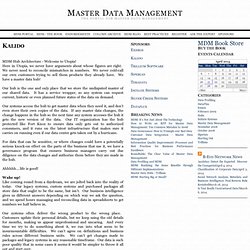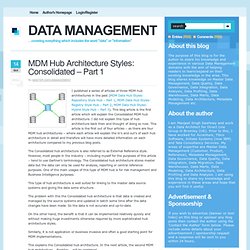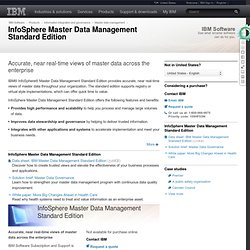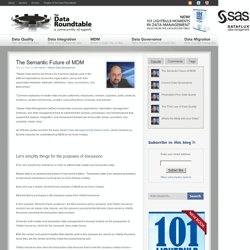

RoI of MDM. Optimize your master data management strategy with this kit. Top 13 master data management (MDM) buzzwords and definitions. Components of MDM. Data Governance - where to start. Master Data Management. MDM Hub Architecture - Welcome to Utopia!

Here in Utopia, we never have arguments about whose figures are right. We never need to reconcile mismatches in numbers. We never cold-call our own customers trying to sell them products they already have. We have a master data hub! Our hub is the one and only place that we store the undisputed master of our shared data. Our systems access the hub to get master data when they need it, and don’t even store their own copies of the data. For data that can be sensitive, or where changes could have a potentially serious knock-on effect on the parts of the business that use it, we have a governance program that ensures business managers carry out due diligence on the data changes and authorize them before they are made in the hub.
Ahhhhh….life is good! Wake up! Like coming round from a daydream, we are jolted back into the reality of today. Our systems often deliver the wrong product to the wrong place. Utopia seems like such a long way off. Pros: Cons: IRM UK - Conferences - Master Data Management Summit Europe 2013 and Data Governance Conference Europe 2013 - 15-17 April 2013 - London - MDM_DG_2013_Web_Brochure.pdf. MDM Hub Architecture Styles: Consolidated – Part 1. I published a series of articles of three MDM hub architectures in the past (MDM Data Hub Styles: Repository Style Hub – Part 1, MDM Data Hub Styles: Registry Style Hub – Part 2, MDM Data Hub Styles: Hybrid Style Hub – Part 3).

This blog article is the first article which will explain the Consolidated MDM hub architecture. I did not explain this type of hub architecture back then and thought of doing so now. This article is the first out of four articles – as there are four MDM hub architectures – where each article will explain the in’s and out’s of each hub architecture in detail and therefore will have more detailed information on each architecture compared to my previous blog posts. The Consolidated hub architecture is also referred to as External Reference style. However, most people in the industry – including myself for the purposes of this article – tend to use Gartner’s terminology. This explains the Consolidated hub architecture. Rating: 5.0/5 (4 votes cast) Author on Linkedin. The What, Why, and How of Master Data Management. Roger Wolter and Kirk Haselden Microsoft Corporation November 2006 Applies to: Master Data Management (MDM) Service-Oriented Architecture (SOA) Software as a Service (SaaS) Summary: The recent emphasis on regulatory compliance, SOA, and mergers and acquisitions has made the creating and maintaining of accurate and complete master data a business imperative.
This paper covers the reasons for adopting master-data management, the process of developing a solution, and several options for the technological implementation of the solution. (12 printed pages) Contents. InfoSphere Master Data Management Standard Edition - Software. Accurate, near real-time views of master data across the enterprise IBM® InfoSphere® Master Data Management Standard Edition provides accurate, near real-time views of master data throughout your organization.

The standard edition supports registry or virtual style implementations, which can offer quick time to value. InfoSphere Master Data Management Standard Edition offers the following features and benefits: Provides high performance and scalability to help you process and manage large volumes of data.Improves data stewardship and governance by helping to deliver trusted information.Integrates with other applications and systems to accelerate implementation and meet your business needs. More Less High performance and scalability Provides a virtual engine to help you quickly establish a single data registry for existing systems.
The What, Why, and How of Master Data Management. Code_lists.pdf (application/pdf Object) MDM & Data Governance Events. Review of "Top 15" MDM Software Solutions. TWDI - Next Generation Master Data Management. The Data Roundtable - The Semantic Future of MDM. Mar 24, 2010 by Jim Harris in Master Data Management “Master data objects are those core business objects used in the different applications across the organization, along with their associated metadata, attributes, definitions, roles, connections, and taxonomies.”

“Common examples of master data include customers, employees, vendors, suppliers, parts, products, locations, contact mechanisms, profiles, accounting items, contracts, and policies.” Review master data management talend.